| Malus domestica Borkh 'Cornish Aromatic' | |
|---|---|
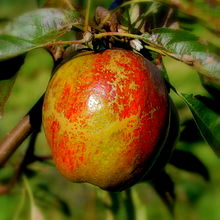 | |
| Cultivar | 'Cornish Aromatic' |
| Origin | introduced 1813 [1] |

Cornish Aromatic is an apple cultivar with a crisp, nut-like aromatic flavour that was first recorded in Cornwall in 1813. [2] [3]
| Malus domestica Borkh 'Cornish Aromatic' | |
|---|---|
 | |
| Cultivar | 'Cornish Aromatic' |
| Origin | introduced 1813 [1] |

Cornish Aromatic is an apple cultivar with a crisp, nut-like aromatic flavour that was first recorded in Cornwall in 1813. [2] [3]
According to the biologist Robert Hogg in his work "British Pomology" [4]
High-quality dessert apple.
- History: Found growing in Cornwall, England. Brought to notice in 1813.
- Shape: Fruit, above medium size, 77mm wide, and 69mm high; roundish, angular, slightly flattened, and narrowing towards the eye. Skin, yellow on the shaded side, and covered with large patches of pale brown russet, which extend all over the base, and sprinkled with green and russety dots; but of a beautiful bright red, which is streaked with deeper red, and strewed with patches and dots of russet on the side exposed to the sun. Eye small and closed, with long flat segments, which are reflexed at the tips and set in an irregular basin. Stalk short, inserted in a deep and narrow cavity which is lined with russet.
- Flesh yellowish, firm, crisp, juicy, rich, and highly aromatic. A valuable dessert apple of first-rate quality.
- Picking: mid October.
- Use October-March.
- Tree is a free grower and an excellent bearer. [5]

The Egremont Russet is a cultivar of dessert apple, of the russet type. It has a rich, nutty flavour and crisp, firm and fairly juicy flesh.
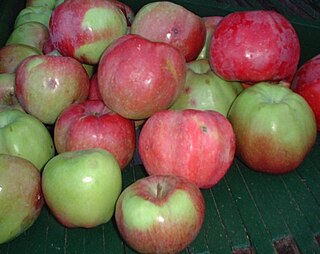
The Northern Spy, also called 'Spy' and 'King', is a cultivar of domesticated apple that originated on the farm of Oliver Chapin in East Bloomfield, New York in about 1840. It is popular in upstate New York.

The Cornish Gilliflower is a cultivar of apple.

'Ribston Pippin' is a triploid cultivar of apples, also known by other names including 'Essex Pippin', 'Beautiful Pippin', 'Formosa', 'Glory of York', 'Ribstone', 'Rockhill's Russet', 'Travers', and 'Travers's Reinette'.

A pearmain, also formerly spelt "permain", is a type of apple. The name may once have been applied to a particular variety of apple that kept well, although in more modern times its inclusion in varietal names was, like the term 'Pippin', "largely decoration" rather than indicating any shared qualities.

Ashmead's Kernel is a triploid cultivar of apple. Traditionally, Ashmead's Kernel was thought to be diploid but a poor pollinator.
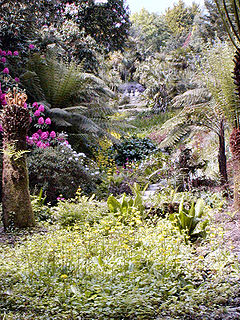
Cornwall is the county that forms the tip of the southwestern peninsula of England; this area has a mild and warm climate regulated by the Gulf Stream. The mild climate allows rich plant cover, such as palm trees in the far south and west of the county and in the Isles of Scilly, due to sub-tropical conditions in the summer.

Claygate Pearmain is an apple cultivar. It was found at Claygate, Surrey in England and brought to the attention of the Royal Horticultural Society by John Braddick in 1821. The apple was a popular eating apple in Victorian times and spread through England and to America.

The Kingston Black, also known as Black Taunton, is a cultivar of apple originating from the United Kingdom and used in making cider. The name of the cultivar comes from the apples' dark red or purplish skin, though despite the name, the fruit does not have a black hue.
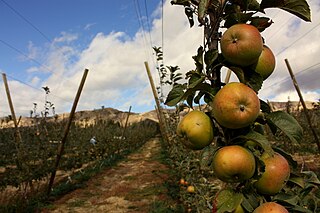
The Newtown Pippin, also known as Albemarle Pippin, is an American apple that originated in the late 17th or early 18th century and is still cultivated on a small scale. At one time, there were two very similar apple cultivars known as the 'Yellow Newtown' and 'Green Newtown', one of which perhaps originated as a sport of the other.

'Adams Pearmain', also called 'Adam's Parmane', is a cultivar of apple. It was introduced to the Horticultural Society of London in 1826 by Robert Adams, under the name 'Norfolk Pippin'. The fruit is large, varying from two and a half inches to three inches high, and about the same in breadth at the widest part. It is pearmain-shaped, very even, and regularly formed. The skin is pale yellow tinged with green, and covered with delicate russet on the shaded side; but deep yellow tinged with red, and delicately streaked with livelier red on the side facing the sun. The flesh is yellowish, crisp, juicy, rich, and sugary, with an agreeable and pleasantly perfumed flavour.

Liberty is a hybrid apple cultivar developed by the New York State Agricultural Experiment Station. It was a seedling produced in 1955 from pollinating 'Macoun' from 'Purdue 54-12' for the sake of acquiring Malus floribunda disease resistances. It was first released to the public in 1978.
'Brown Snout' is a 19th-century cultivar of cider apple originating in Herefordshire in the United Kingdom, though now grown in other counties and parts of the world.

The Foxwhelp is a very old cider apple cultivar, originating in the west Midlands of England.

A 'Stayman' is a triploid apple cultivar developed in 1866 by Joseph Stayman of Leavenworth County, Kansas; it was sold by nurseries from 1895. 'Stayman' apples remain a locally popular cultivar of apples where grown.
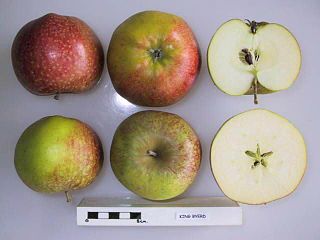
The King Byerd is a cultivar of domesticated apple, that originated in Cornwall. It is primarily used for cooking.

Fiesta is a modern cultivar of domesticated apple which is often marketed as Red Pippin. It was developed in the United Kingdom by breeders at the East Malling Research Station, combining the Cox's Orange Pippin with the Idared apple. According to the Orange Pippin website, it is one of the best Cox's style apples, but much easier to grow having good disease resistance.
Dufflin is an old variety of cider apple from the County of Cornwall, England. It was included in orchard trials by Long Ashton Research Station in 1957.

The Bloody Ploughman is a domesticated apple cultivar. The cultivar originated in Scotland.